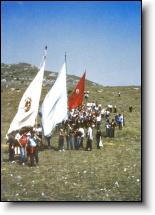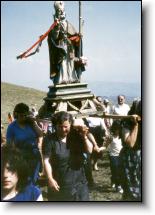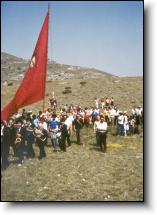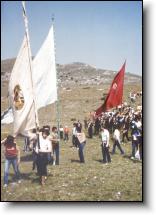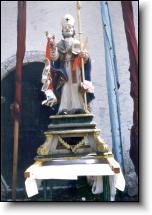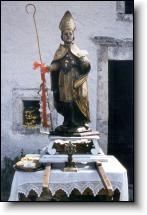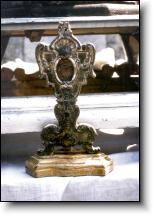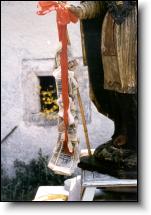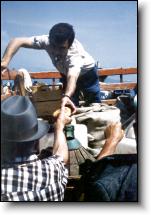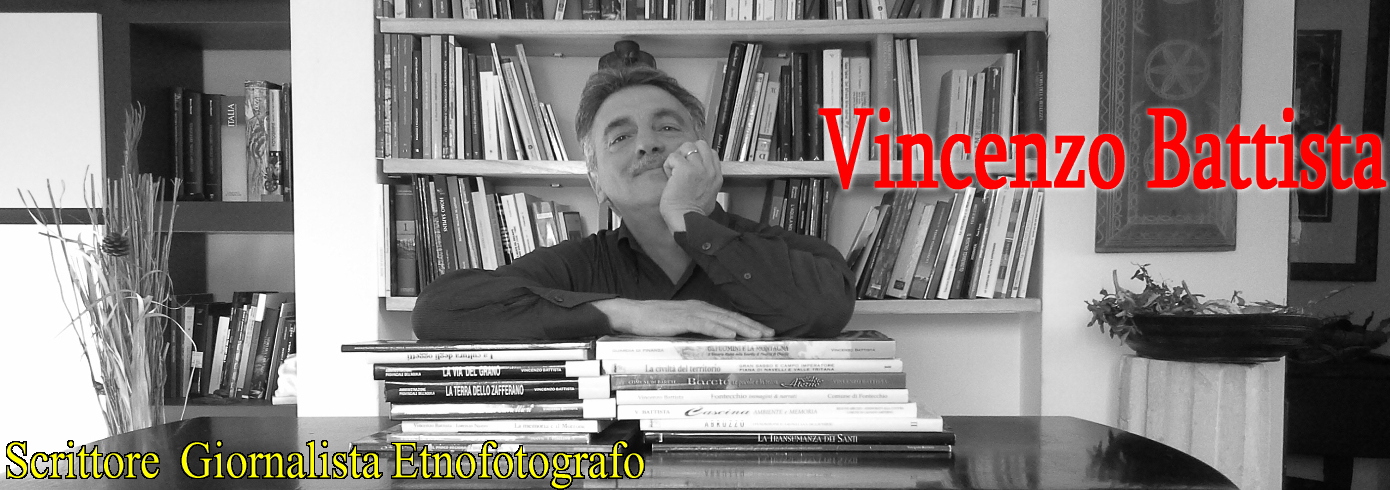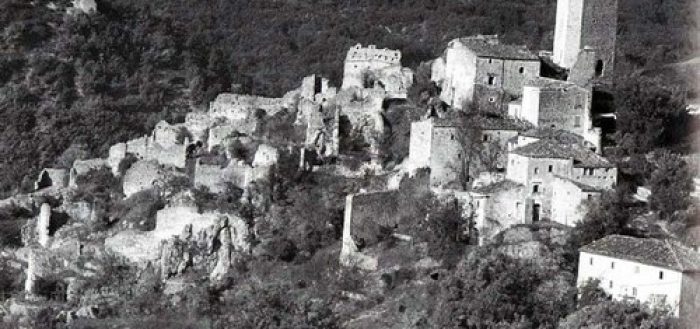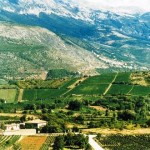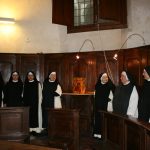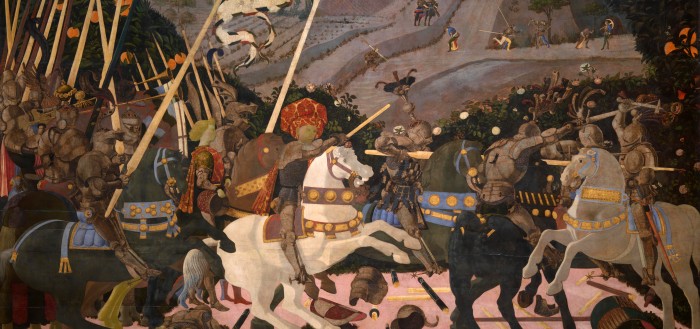Testo e fotografia di Vincenzo Battista.
L’ultimo tratto della processione, durata diverse ore e giunta nei pressi della chiesa di Sant’Erasmo. Partita da Beffi e Succiano, frazioni di Acciano, la processione ha superato la valle del “Santissimo”, ha poi risalito “i calmi” e le coste di Sant’Erasmo (m 1303 slm) che divide la media valle dell’Aterno dalla Piana di Navelli. La zona, coltivata un tempo con legumi e cereali, viene benedetta dal sacerdote che precede il corteo religioso. Gli stendardi, insieme alle due statue dei santi, hanno attraversato un paesaggio impervio, segnando così il territorio che di volta in volta viene benedetto per propiziare i nuovi raccolti agricoli, secondo gli intendimenti della tradizione popolare.
I tre stendardi (azzurro, la Madonna di Loreto; bianco, Sant’Antonio; rosso, Sant’Erasmo) vengono portati a turno dalla comunità di Acciano insieme alla statua del santo. Le donne portano, nell’ultimo tratto del percorso, la statua del santo: una prova penitenziale per sciogliere il voto a Sant’Erasmo.
La statua di Sant’Erasmo di Beffi. La celebrazione della messa davanti la chiesa di Sant’Erasmo con le due statue dei santi di Beffi e Succiano segna la raggiunta concordia tra le due comunità, che per secoli si sono contese il diritto di precedenza sul “sentiero di Sant’ Erasmo”, assegnato poi alla statua di Beffi.
Le offerte dei pellegrini. Sant’Erasmo è uno dei santi “ausiliatori” a cui i cristiani fanno ricorso per particolari necessità. La devozione sembra essere sorta nel XIII secolo in Germania. Ha avuto larga diffusione nell’Europa centro-meridionale. Il pellegrinaggio che interessa l’area di Acciano si compie la prima domenica di giugno.
Il reliquario in argento contiene frammenti delle ossa di Sant’Erasmo. La processione, partita da una quota di 700 metri, sale fino a monte Offermo (1303 metri) e raggiunge il santuario a quota 1165 metri dopo molte ore di cammino. Secondo la tradizione il luogo dove sorge la chiesa attesta la sosta del santo in una sua visita in Abruzzo.
La chiesa di Sant’Erasmo, probabilmente costruita intorno al XVI secolo su una preesistente edicola votiva dedicata allo stesso santo, conserva alcuni locali utilizzati in passato per il ricovero dei pastori. Nella piccola cappella un altare in pietra è incastrato in una nicchia ed un affresco che raffigura Sant’Erasmo viene invocato per le malattie intestinali.
I panicelli benedetti vengono offerti in segno di devozione davanti alla chiesa. Riportati nelle case dei centri vallivi dell’Aterno, secondo gli intendimenti della tradizione orale, se collocati fuori dalle finestre, hanno la capacità di fermare i temporali e la grandine sui raccolti.
Traduzione Piera Badia
Show the final moments of the procession, which lasted for several hours, now almost at the church of St. Erasmus. Two processions started from Beffi and Succiano, two hamlets of the municipality of Acciano, passed through the “Santissimo” valley, then climbed over the “i calmi” and crests of the mountain of Sant’Erasmo (1303 meters a.s.l.) whist divides the Middle Aterno Valley from the Navelli Plain. The area, where once all kids of beans and cereals were grown, is blessed by the priest walking at the front of the procession. The standards and the two statues of the saint are carried through a very rugged terrain, and every little while the soil is blessed, to ask for good harvests, according to the folk tradition. The three standards (the blue one for the Madonna di Loreto; the white one for St. Anton; the red one for St. Erasmus), as well as the saint’s statue, are carried in turns by the people of Acciano.
This is the statue of St. Erasmus of the people of Beffi.
The celebration of a Mass before the church of St. Erasmus with the two statues of the saint from Beffi and Succiano is a sign of the peace finally achieved between the two communities that for centuries used to fight for right of way rights along the “path of St. Erasmus”, a right that was finally granted to Beffi.
The offers of the pilgrims.
St. Erasmus is one of the “helping” saints whom Catholic people pray on special needs. The cult seems to take origin from Germany in the 13th century, and spread throughout Central and Southern Europe. The pilgrimage in the Acciano area takes place on the first Sunday in June.
The relic holder in silver contains bone fragments of St. Erasmus. The procession leaves from an altitude of 700 meters and clibms up to Mount Offermo (1303 meters) to finally reach the sanctuary which rises at 1165 meters after many hours. According to the tradition, the sanctuary rises on the spot where the saint rested during a visit to Abruzzo.
The church of St. Erasmus was built in the 16th century, possibly on a previous chapel, also built in honor of the saint, and still shows some locals used in the bast by shepherds for shelter. In the small chapel there is a stone altar, carved into a niche and a fresco showing St. Erasmus, who is also prayed for bowel disorders.
The blessed loaves are offered before the church as a sign of devotion. Once taken back to the homes, popular belief says that they, if placed outside the windows, can avoid thunderstorms and hail from destroying the harvest.


